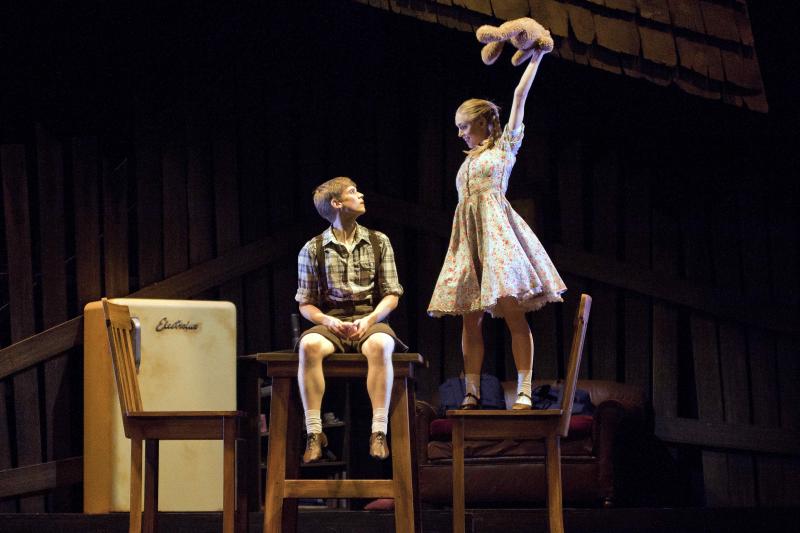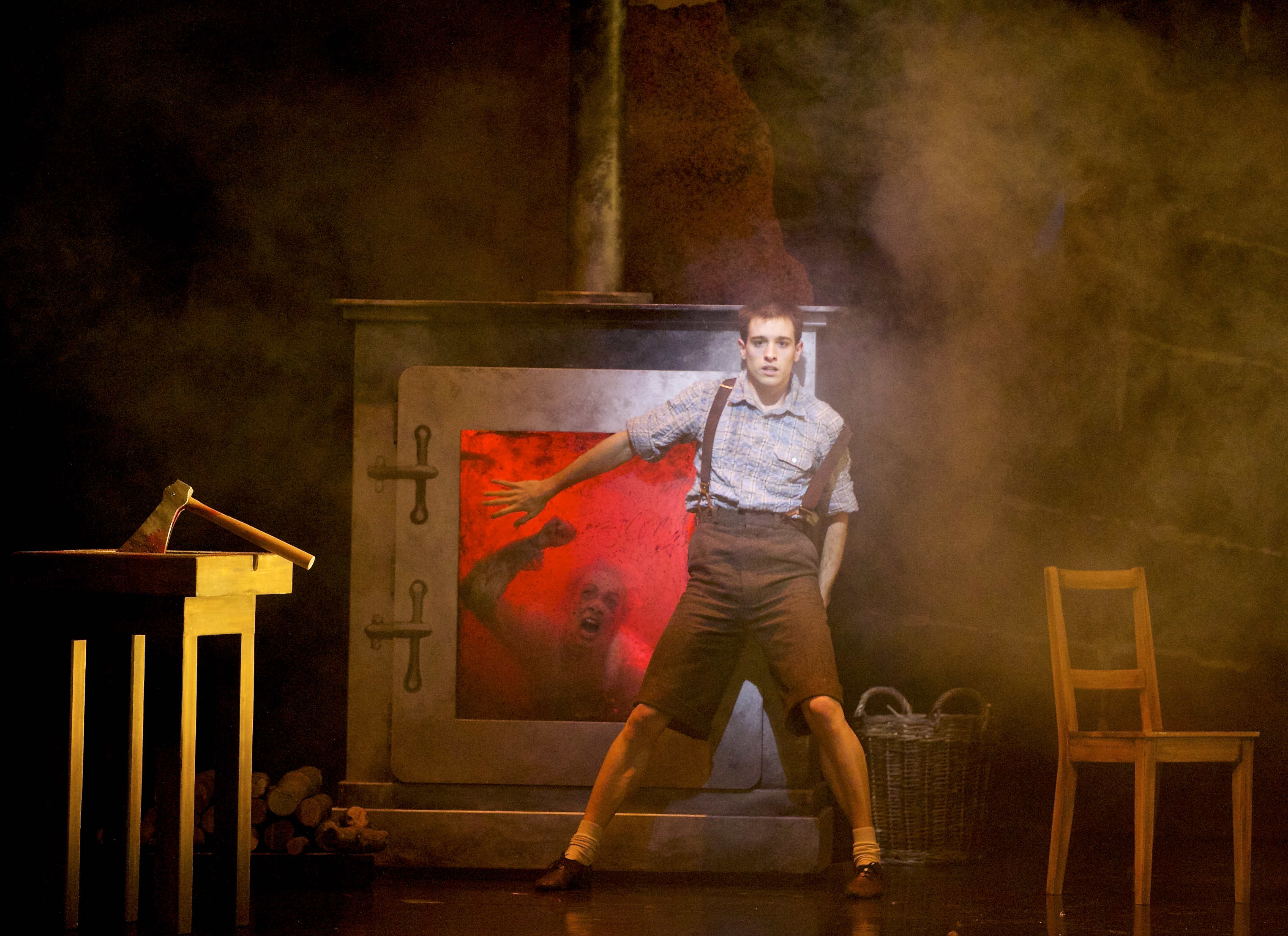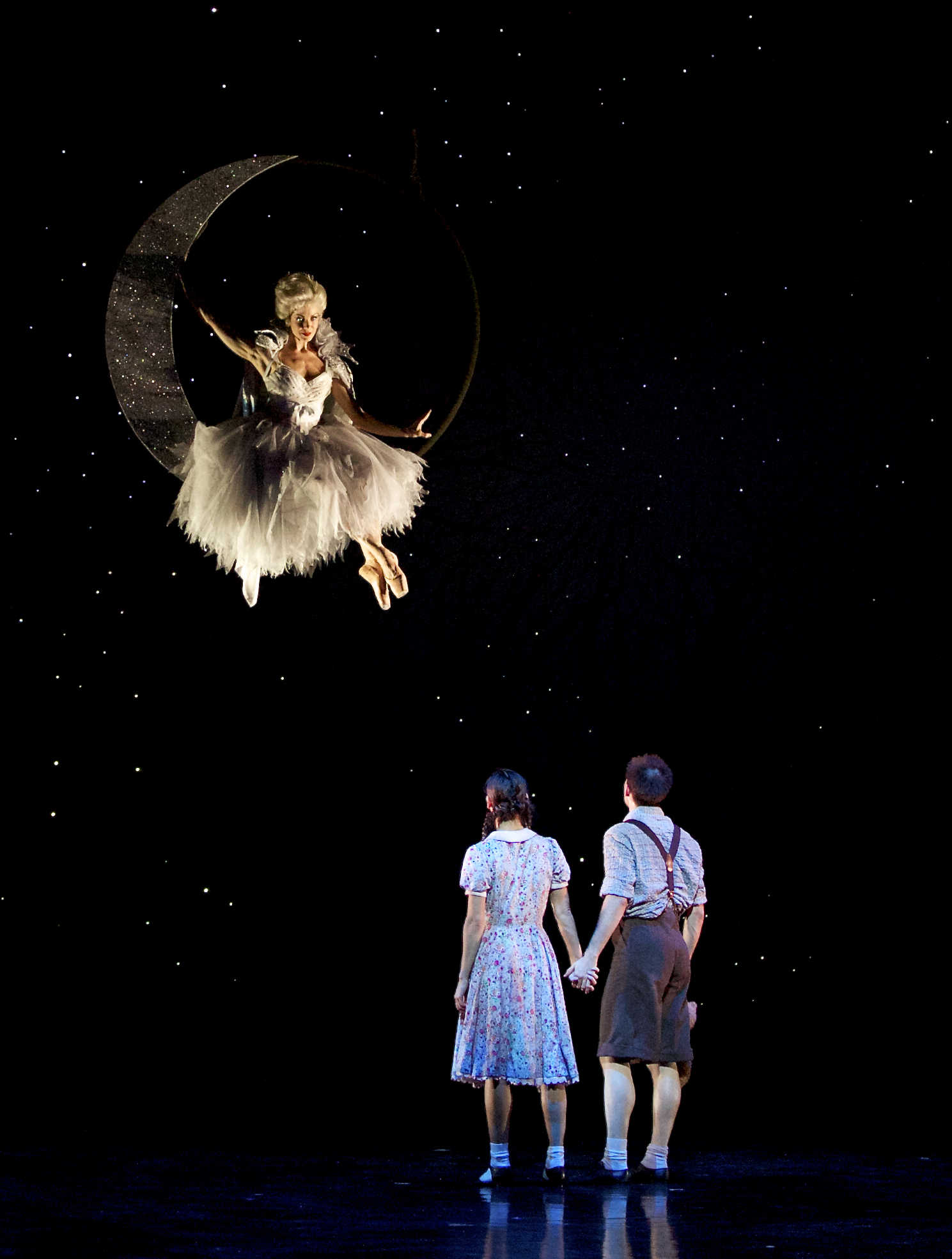Hansel and Gretel, Scottish Ballet, Theatre Royal, Glasgow | reviews, news & interviews
Hansel and Gretel, Scottish Ballet, Theatre Royal, Glasgow
Hansel and Gretel, Scottish Ballet, Theatre Royal, Glasgow
Sugar-coated new Christmas show looks good, but lacks bite

When he became Artistic Director of Scottish Ballet in 2002, Ashley Page’s first creation for the company was a witty, pacy, Nutcracker, the kind of box-office friendly production all companies need to win the hearts of the public and stabilise the finances.
Aiming squarely at the family market, Hampson - following Engelbert Humperdinck, from whose 1893 opera much of the ballet’s music derives - removes what is perhaps the scariest element in the Grimms’ original tale, the deliberate abandonment of the two children by their parents; instead, his Hansel (Jamiel Laurence) and Gretel (Constance Devernay) have a happy home life in a slightly jollified version of 1950s small-town Scotland, skilfully evoked by Caro Harkness’s costumes. All the evil they encounter is in the outside world, where the town’s children are disappearing and a glamorous schoolteacher (the gorgeously enticing Sophie Martin) is handing out lollipops.
Curiosity, rather than hunger or fear, leads Hansel and Gretel to leave home (where Quenby Hersh’s floral-apronned Mother and Remi Andreoni’s beer-swilling Father are contentedly snoozing on the sofa), but once outside they are menaced by the Ravens, three leather-jacketed rockers who later glam up with black feathers, and lured into the forest. The Ravens eat the crumbs Hansel drops to try and mark the way home, and when the exhausted children fall asleep (at the behest of a Sandman, Erik Cavallari), they dream of their parents at a ball, then of a banquet with chefs and waiters aplenty (finally! Something for the corps de ballet to do!). After being woken by a Dewdrop Fairy (Laura Joffre), they end up in a gingerbread house where – surprise! - the glamorous schoolteacher turns out to be a wicked witch and...well, you know the rest.
 Despite a couple of chilling moments, mostly courtesy of Gary Harris’s designs (the bloody axe stuck in a butcher’s block is a highlight, as is the witch’s fiery end in the oven, both pictured left), this is Grimm-lite. Parents may be grateful for the lack of nightmare fodder, but for adults it is sadly bland. I hold Humperdinck’s music largely responsible, tuneful and harmonious though it is, and delicately coloured by the Scottish Ballet orchestra under Richard Honner’s baton. Hampson, Honner and Brian Prentice selected and arranged the music from Hänsel und Gretel, padding it with passages from Humperdinck’s other compositions, and if the resulting score is to be believed, 95% of the German’s oeuvre was 4/4, mezzo forte, and 60 beats a minute, with neither pizzazz, passion, or pace for dancers to exploit. With a score this anodyne, it’s very hard to evoke evil, fear or the joy of reunion, and there are no exhilarating dance setpieces like Tchaikovsky’s flower waltzes to lift the spirits.
Despite a couple of chilling moments, mostly courtesy of Gary Harris’s designs (the bloody axe stuck in a butcher’s block is a highlight, as is the witch’s fiery end in the oven, both pictured left), this is Grimm-lite. Parents may be grateful for the lack of nightmare fodder, but for adults it is sadly bland. I hold Humperdinck’s music largely responsible, tuneful and harmonious though it is, and delicately coloured by the Scottish Ballet orchestra under Richard Honner’s baton. Hampson, Honner and Brian Prentice selected and arranged the music from Hänsel und Gretel, padding it with passages from Humperdinck’s other compositions, and if the resulting score is to be believed, 95% of the German’s oeuvre was 4/4, mezzo forte, and 60 beats a minute, with neither pizzazz, passion, or pace for dancers to exploit. With a score this anodyne, it’s very hard to evoke evil, fear or the joy of reunion, and there are no exhilarating dance setpieces like Tchaikovsky’s flower waltzes to lift the spirits.
 With so little help from the music, it’s all up to the dancers to shape the emotional story arc, and they do their best, with Constance Devernay’s Gretel a particular star for her fresh energy and expansive jumps. Hampson’s choreography of the storytelling/acting sequences is rather good: fluid, expressive and contemporary. But many of his danced variations have an exam-board quality, as if the dancers are being required to tick off things they can do (move on straights and diagonals, turn left and right, beat front and back), and Hampson is obviously fond of awkward morsels like developpés out of posé turns. Perhaps because only turgid music accompanies these technical challenges, there were stumbled landings and clumsy turns galore last night, even from principals.
With so little help from the music, it’s all up to the dancers to shape the emotional story arc, and they do their best, with Constance Devernay’s Gretel a particular star for her fresh energy and expansive jumps. Hampson’s choreography of the storytelling/acting sequences is rather good: fluid, expressive and contemporary. But many of his danced variations have an exam-board quality, as if the dancers are being required to tick off things they can do (move on straights and diagonals, turn left and right, beat front and back), and Hampson is obviously fond of awkward morsels like developpés out of posé turns. Perhaps because only turgid music accompanies these technical challenges, there were stumbled landings and clumsy turns galore last night, even from principals.
It’s only fair to acknowledge that I saw the third cast, the ones who normally do matinées for the under fives, and the story may well be more compelling as danced by the first cast, on whom it was created (Constant Vigier as Hansel, Sophie Martin as Gretel, the fantastic Eve Mutso as the Witch, pictured above right). But even the most charismatic actors and assured dancers will struggle to make up for the fundamental lack of excitement in both music and choreography. This is a good starter ballet for the uninitiated – easy on the ear, easy on the eye, clear story – and I hope it does well at the box office, but for me, this gingerbread fairytale is just too vanilla.
- Hansel and Gretel is at the Theatre Royal, Glasgow until 28 December, then goes on tour to Edinburgh, Aberdeen, Inverness, Newcastle and Belfast from 8 January to 8 February
rating
Buy
Explore topics
Share this article
more Dance
 MacMillan Celebrated, Royal Ballet review - out of mothballs, three vintage works to marvel at
Less-known pieces spanning the career of a great choreographer underline his greatness
MacMillan Celebrated, Royal Ballet review - out of mothballs, three vintage works to marvel at
Less-known pieces spanning the career of a great choreographer underline his greatness
 Carmen, English National Ballet review - lots of energy, even violence, but nothing new to say
Johan Inger's take on Carmen tries but fails to make a point about male violence
Carmen, English National Ballet review - lots of energy, even violence, but nothing new to say
Johan Inger's take on Carmen tries but fails to make a point about male violence
 WAKE, National Stadium, Dublin review - a rainbow river of dance, song, and so much else
THISISPOPBABY serves up a joyous tapestry of Ireland contemporary and traditional
WAKE, National Stadium, Dublin review - a rainbow river of dance, song, and so much else
THISISPOPBABY serves up a joyous tapestry of Ireland contemporary and traditional
 Swan Lake, Royal Ballet review - grand, eloquent, superb
Liam Scarlett's fine refashioning returns for a third season, and looks better than ever
Swan Lake, Royal Ballet review - grand, eloquent, superb
Liam Scarlett's fine refashioning returns for a third season, and looks better than ever
 First Person: Ten Years On - Flamenco guitarist Paco Peña pays tribute to his friend, the late, great Paco de Lucía
On the 10th anniversary of his death, memories of the prodigious musician who broadened the reach of flamenco into jazz and beyond
First Person: Ten Years On - Flamenco guitarist Paco Peña pays tribute to his friend, the late, great Paco de Lucía
On the 10th anniversary of his death, memories of the prodigious musician who broadened the reach of flamenco into jazz and beyond
 Dance for Ukraine Gala, London Palladium review - a second rich helping of international dancers
Ivan Putrov's latest gala was a satisfying mix of stars and young hopefuls
Dance for Ukraine Gala, London Palladium review - a second rich helping of international dancers
Ivan Putrov's latest gala was a satisfying mix of stars and young hopefuls
 Nelken: A Piece by Pina Bausch, Sadler's Wells review - welcome return for an indelible classic
A new generation of gifted performers for us to get to know
Nelken: A Piece by Pina Bausch, Sadler's Wells review - welcome return for an indelible classic
A new generation of gifted performers for us to get to know
 Dark With Excessive Bright, Royal Ballet review - a close encounter with dancers stripped bare
The Royal's Festival of New Choreography launches with an unforgettable walk in the dark
Dark With Excessive Bright, Royal Ballet review - a close encounter with dancers stripped bare
The Royal's Festival of New Choreography launches with an unforgettable walk in the dark
 La Strada, Sadler's Wells review - a long and bumpy road
Even the exceptional talents of Alina Cojocaru can't save dance adaptation of Fellini film
La Strada, Sadler's Wells review - a long and bumpy road
Even the exceptional talents of Alina Cojocaru can't save dance adaptation of Fellini film
 First Person: pioneering juggler Sean Gandini reflects on how the spirit of Pina Bausch has infiltrated his work
As Tanztheater Wuppertal Pina Bausch's 'Nelken' comes to Sadler’s Wells, a tribute from across the art forms
First Person: pioneering juggler Sean Gandini reflects on how the spirit of Pina Bausch has infiltrated his work
As Tanztheater Wuppertal Pina Bausch's 'Nelken' comes to Sadler’s Wells, a tribute from across the art forms
 Manon, Royal Ballet review - a glorious half-century revival of a modern classic
Fifty years on, Kenneth MacMillan's crash-and-burn anti-heroine is riding high
Manon, Royal Ballet review - a glorious half-century revival of a modern classic
Fifty years on, Kenneth MacMillan's crash-and-burn anti-heroine is riding high
 Giselle, English National Ballet, Coliseum review - if you go down to the woods today, beware of the Wilis
A revival of Mary Skeaping's lovingly researched production, packed with lively detail and terrific suspense
Giselle, English National Ballet, Coliseum review - if you go down to the woods today, beware of the Wilis
A revival of Mary Skeaping's lovingly researched production, packed with lively detail and terrific suspense

Add comment